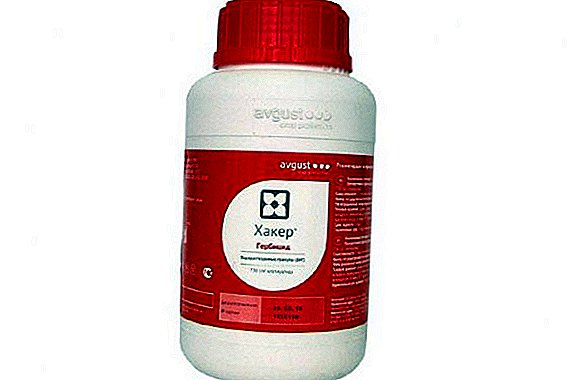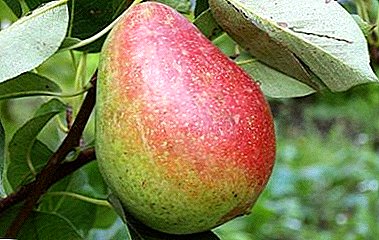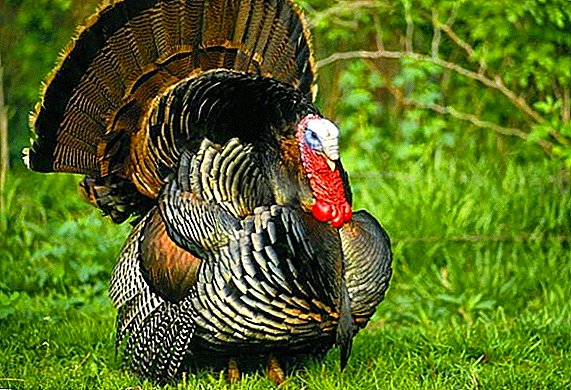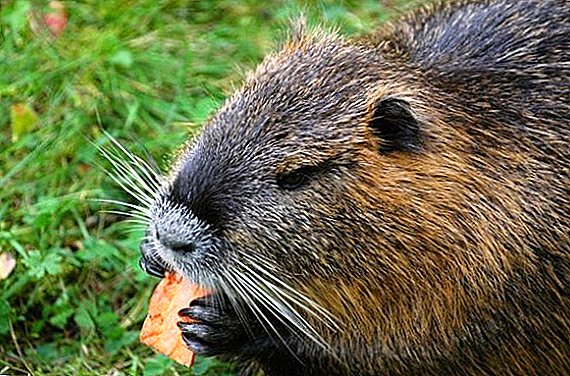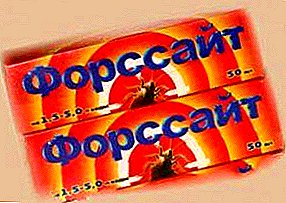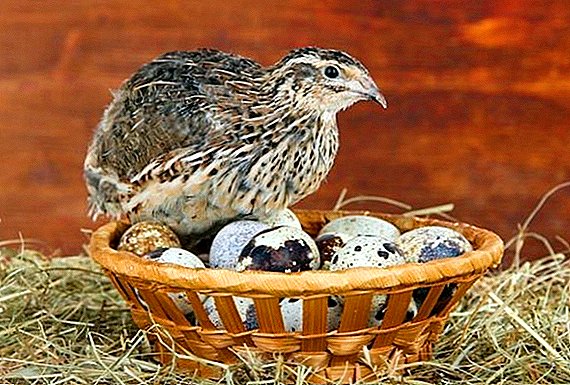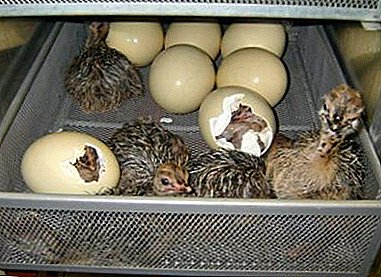
Incubation of ostrich eggs is quite a profitable business. Thanks to artificial incubation, it is possible to get healthy and complete offspring.
But this is subject to compliance with all the rules and recommendations, because incubation is not such a simple process. It requires increased attention and great responsibility. Read about it in this article.
What is this process for?
Incubation is a complex process that requires compliance with certain rules and requirements. This is a period of time necessary for the full cycle of the development of the organism.. For these purposes, a special apparatus is used in which optimal conditions are created for the ripening of the fetus. This allows you to speed up the process of hatching chicks, as well as reduce the development of pathologies.
Structural Features and Pretreatment
 The ostrich egg consists of water, nutrients and mineral components.. It contains all the elements that are so important for embryos during incubation and after the incubation period.
The ostrich egg consists of water, nutrients and mineral components.. It contains all the elements that are so important for embryos during incubation and after the incubation period.
And although ostrich eggs of one species are similar in manifestations, they can have significant differences in shell porosity and size. Their shells should be covered with a cuticle. It is a natural barrier against the penetration of microbes. In addition, the same task is performed by the protein substance.
The ostrich egg has the shape of an ellipse. Visually determine where the sharp and rounded tip is difficult. Shell looks like porcelain and has pores. They can be small and inconspicuous for different species of birds.
Selection and storage
Incubation material should be collected as soon as possible after it has been torn down. Egg storage occurs at a temperature of 16-18 degrees. Storage time is not longer than 7 days. Every day is worth turning them.
Disinfection
Before laying the material in the incubator, it is necessary to disinfect it and remove the existing contamination. If you scrape the shell with a brush, it will cause an increase in embryonic mortality. The fact is that during such a manipulation the shell can be damaged, its pores are clogged and the air exchange is broken.
Preparation of the solution
Virkon-S is used to remove dirt from eggs. For 1 liter of water, take 2-3 g of the substance. Water for washing should be warm. If you use cold water, it will lead to a reduction in the air space of the pores of the shell, which will cause the penetration of harmful microbes and bacteria into the eggs.
When washing eggs, the following recommendations should be followed.:
- For cleaning works, a soft brush is required.
- The cleaning solution should be 5 degrees warmer than the eggs.
- After washing, dry the material.
Stages of embryo development
When the ostrich eggs in the incubator are x-rayed, there are several stages of their development:
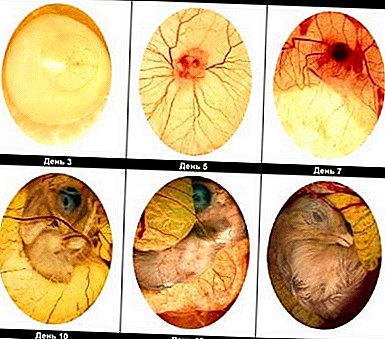 On the 7th day in the fertilized egg there is a shadow of allantois. It lines 20% of the shell surface.
On the 7th day in the fertilized egg there is a shadow of allantois. It lines 20% of the shell surface.- On the 14th day this shadow is easily distinguishable. It increases, taking the upper surface of the egg by ½. Further the shadow becomes more and more.
- On the 24th day 1/6 of the egg is occupied by the air chamber, and ½ - by the embryo.
- On the 33rd day embryo occupies 2/3 volume.
- Starting from the 35th day almost nothing can be distinguished, because the egg is completely filled with an embryo.
Incubator features and table with modes
TIP: For artificial incubation, it is necessary to use special incubators designed for large ostrich eggs.
Modern devices are equipped with various functions, thanks to which it is possible to control the whole incubation process in automatic mode. Temperature indicators should be in the range of 36-36.4 degrees.
Modern models are able to independently monitor the temperature, humidity, air exchange, and they are also equipped with an automatic egg turning function. The incubation period for ostrich eggs is 42-43 days.. Before hatching chicks (at 41-42 days), eggs should be transferred to a special hatcher.
Table 1 - Temperature and humidity conditions for incubating eggs at home
| Day of incubation | Temperature, 0С | Humidity,% | Egg position | Turns trays, times |
| 1-14 | 36,3-36,5 | 20-25 | Vertical or horizontal | 24 |
| 15-21 | 36,3-36,5 | 20-25 | vertical | 24 |
| 22-31 | 36,3-36,5 | 20-25 | vertical | 3-4 |
| 32-38 | 35,8-36,2 | 20-25 | vertical | - |
| 39-40 | 35,8-36,2 | 40-45 | Vertical or horizontal | - |
| 41-43 | 35,8-36,2 | 60-70 | vertical | - |
If you want to make an incubator with your own hands, you can read this article.
Process features
 After selection, ostrich eggs are washed, disinfected and stored at a temperature of 15-18 degrees. It is necessary to turn them over 2 times a day. After transportation, the material is fumigated with formaldehyde. Egg incubation takes place in cabinets with a capacity of 1,690 eggs..
After selection, ostrich eggs are washed, disinfected and stored at a temperature of 15-18 degrees. It is necessary to turn them over 2 times a day. After transportation, the material is fumigated with formaldehyde. Egg incubation takes place in cabinets with a capacity of 1,690 eggs..
On the 10th day of incubation, the eggs must be removed from the incubator and weighed to determine shrinkage. If the egg loses to less than 12 or more than 15%, then they are placed in separate incubation chambers with a different humidity level. Similar monitoring is carried out every 2 weeks. Thus, at the end of the incubation period, it is possible to obtain the maximum number of suitable for breeding chicks.
Finding the right time
The most convenient time for laying eggs is the evening around 18.00. For the output to occur amicably, it is necessary to sort the used material by size. The fact is that at first chicks from small eggs are born, and only then from large ones. First, make a bookmark of large material, after 4 hours - medium and after 4 hours - small.
Translucent
To control the development of the embryo, ovoscopy is used.. The fact is that the shell of ostrich eggs is very thick, so that in the process of scanning you can only see the shadow of fetal butterflies or the embryo.
Ovoskop - this tube, whose length is 1 m and a diameter corresponding to the size of the egg. At the base of the prior there is a lamp whose power is 100 watts. At the opposite end is a rubber ring that protects the shell from damage. After each contacting of the egg with the ring, it must be cleaned with a sponge moistened in a disinfecting solution.
IMPORTANT: It is enough to perform 2 views with the help of an ovoscope - the 13th and 20th day. In addition, it is possible to conduct ovoskopirovaniya every week, up to 39 days.
The most common mistakes
Most often the death of embryos occurs for the following reasons.:
 Infectious pathologies. If there is a fungal or bacterial lesion, then the protein begins to cloud, a putrid odor occurs. Visible raw nodules, which are dead tissue.
Infectious pathologies. If there is a fungal or bacterial lesion, then the protein begins to cloud, a putrid odor occurs. Visible raw nodules, which are dead tissue.- Hereditary diseases. This should include the underdevelopment of the beak, the accretion of two embryos, the underdevelopment of organs.
- Fetal dystrophy. Observed with impaired feeding of the parent pair. The embryos are stunted and poorly absorbed nutrients. The yolk is thick, viscous. Hatched chicks have paralysis.
- Underheated eggs. The development and growth of embryos is inhibited from the very beginning of incubation, increases the time of hatching chicks. If underheating occurs, many chicks, remaining alive, still die.
- Lack of moisture. Eggs begin to lose weight, increasing the size of air chambers. Chicks are born prematurely. The shell is fragile and dry. There is a high death rate.
- Excessive humidity. If the humidity is increased, then the protein is covered by allantois. During ovoscopy on the last days of incubation, in many eggs the boundaries of the air chamber are even, and in the germinal membranes there is liquid. Part of the young are killed due to the drying of the skin and beak to the shell at the site of prokleva.
- Disturbed gas exchange. At the initial stage of incubation, an increased number of deformities occur. In the second half of the incubation, the position of the embryo changes - with its head directed toward the sharp end of the egg.
First steps after elimination
Tolko that appeared chicks should immediately put in a brooder. This is a cage with a pallet, which is equipped with metal grills and heating trays. Keep them there for 2-3 hours so that the ostrichs can dry off. To weigh each hatching nestling in order to control its further development. Disinfect the umbilical cord and hold such events for 2-3 days. The weight of the newly hatched ostrich bird is 500-900 g.
- What is incubation of egg eggs?
- Incubation of turkey eggs.
- Features incubation of peacock eggs.
- The subtleties of incubation of chicken eggs.
- Rules for incubating pheasant eggs.
- Instructions for incubating goose eggs.
- Features incubation of duck eggs.
- Rules for the incubation of quail eggs.
- The process of incubating musk duck eggs.
Incubation of ostrich eggs is a popular procedure that can be performed in both home and farm conditions. In fact, this work is not so difficult, although very important. The farmer should just closely monitor all parameters and create the necessary conditions for the successful development of the embryo and the emergence of healthy straus.


 On the 7th day in the fertilized egg there is a shadow of allantois. It lines 20% of the shell surface.
On the 7th day in the fertilized egg there is a shadow of allantois. It lines 20% of the shell surface. Infectious pathologies. If there is a fungal or bacterial lesion, then the protein begins to cloud, a putrid odor occurs. Visible raw nodules, which are dead tissue.
Infectious pathologies. If there is a fungal or bacterial lesion, then the protein begins to cloud, a putrid odor occurs. Visible raw nodules, which are dead tissue.

